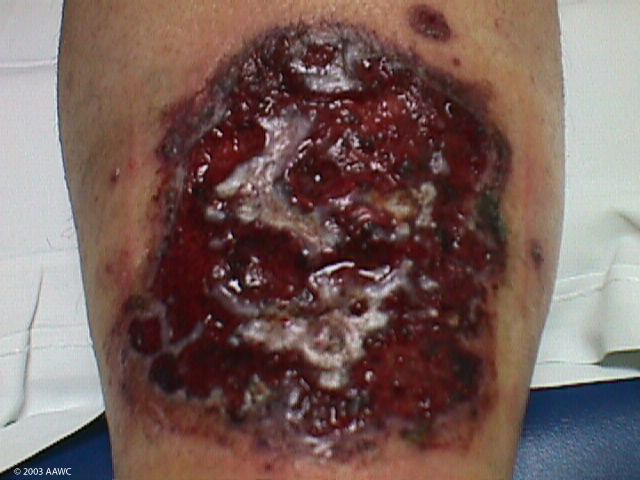Purulent Drainage: Causes, Symptoms, and Treatment
Wound infections are a common concern, and one of the key indicators of infection is purulent drainage. If you’ve noticed unusual fluid oozing from a wound, you’re probably dealing with a form of purulent drainage. WoundEducators will help you understand what purulent drainage is, what causes it, and how to treat it.

What is Purulent Drainage?
Purulent drainage refers to thick, cloudy, or pus-like fluid that comes from an infected wound. This drainage signals that the body is fighting off a bacterial infection. The pus is made up of dead white blood cells, bacteria, and tissue debris, which accumulate as the body attempts to cleanse the area. While not every wound with drainage is infected, purulent drainage is a strong indication that an infection may be present.
Why is Understanding Purulent Drainage Important?
Knowing how to recognize and treat purulent drainage is crucial because ignoring it can lead to serious health issues. Infections that produce purulent drainage can spread rapidly if not treated promptly. Without proper care, complications like sepsis, a potentially life-threatening condition, can arise.
Causes of Purulent Drainage
Common Causes in Wounds
In most cases, purulent drainage forms in response to bacterial infections in wounds. These can result from:
- Surgical incisions that haven’t healed properly
- Minor cuts and scrapes that become contaminated
- Chronic wounds like diabetic ulcers or pressure sores
- Puncture wounds from nails or sharp objects
Infections Leading to Purulent Drainage
When bacteria such as Staphylococcus aureus or Streptococcus infect a wound, the immune system sends white blood cells to the area to fight off the bacteria. The build-up of dead cells and bacteria is what creates the purulent drainage.
Signs and Symptoms of Purulent Drainage

Visual Signs
Purulent drainage is typically thick and can vary in color, ranging from white to yellow, green, or brown, depending on the severity of the infection and the type of bacteria involved. The consistency is often sticky or gooey, and the wound may have an unpleasant odor.
Associated Symptoms
In addition to the drainage, you may experience:
- Increased pain at the wound site
- Swelling or inflammation
- Redness around the wound
- Heat or warmth in the infected area
- Sometimes, fever may develop if the infection spreads.
Types of Purulent Drainage
Not all purulent drainage looks the same. The color and consistency can provide clues about the severity of the infection:
- Yellow or white drainage is often a sign of a mild infection.
- Green or brown pus can indicate a more serious or long-standing infection.
- Foul-smelling pus often signals a severe infection, possibly involving anaerobic bacteria.
Common Locations Where Purulent Drainage Occurs
Certain types of wounds are more likely to produce purulent drainage. These include:
- Surgical wounds: Improper post-surgical care can lead to infections.
- Abscesses and boils: These are infections that build up under the skin.
- Chronic wounds: Diabetic ulcers or pressure sores are especially prone to infection if not properly managed.
Health Risks of Untreated Purulent Drainage
Ignoring purulent drainage can lead to serious health problems. Untreated infections can cause:
- Spread of infection to surrounding tissues and deeper into the body.
- Sepsis, where the infection enters the bloodstream and becomes life-threatening.
- Tissue death, leading to more severe medical intervention like surgery or amputation.
How to Identify Infection in a Wound
You should watch for early signs of infection, such as:
- Redness or streaks radiating from the wound
- Swelling that doesn’t go down
- Persistent pain or tenderness
- Fever
If you see purulent drainage, it’s a sign the infection may be worsening and needs medical attention.
When to Seek Medical Help
If the wound doesn’t improve after a few days of home care, or if you notice signs like increasing pain, fever, or spreading redness, it’s time to consult a healthcare professional. Severe infections may require stronger treatments, including intravenous antibiotics or surgery.
Prevention of Purulent Drainage
Proper Wound Care Techniques
To prevent purulent drainage, ensure wounds are properly cleaned and dressed. Wash hands before touching the wound and keep it covered with sterile bandages.
Sterility and Hygiene Measures
Always use clean materials when treating wounds. Changing bandages regularly and keeping the wound dry can significantly reduce the risk of infection.
Role of Antibiotics in Treating Infections
Following your doctor’s advice for antibiotic treatment is critical. Misuse or incomplete use of antibiotics can lead to antibiotic-resistant bacteria, making future infections harder to treat.
Complications from Improper Treatment
Improper treatment of an infected wound can lead to long-term complications. Without care, infections can spread deeper, leading to issues like bone infections, the need for surgery, or even amputation in extreme cases.
Managing Chronic Wounds with Purulent Drainage
Chronic wounds require specialized care. Regular cleaning, advanced wound dressings, and medical intervention are often needed to manage ongoing infections.
Conclusion
Purulent drainage is a sign that your body is fighting an infection. Recognizing it early and treating it appropriately is essential to preventing serious health risks. Whether through home care or medical intervention, proper wound management can save you from future complications.
Purulent Drainage FAQs
What should I do if my wound has purulent drainage?
Clean the wound, apply an antibiotic cream, and see a doctor if symptoms persist.
How long does it take for an infected wound to heal?
The healing time for an infected wound depends on the severity of the infection and how promptly it’s treated. For mild infections, with proper care and antibiotics, a wound may heal within a week to 10 days. More severe infections can take several weeks or even months to heal, especially if the infection is deep or involves complications. Chronic wounds, like diabetic ulcers, may take longer and often require ongoing medical treatment. It’s important to follow medical advice and ensure the infection is fully cleared to prevent recurrence.
What color is normal for wound drainage?
Normal wound drainage is typically clear or slightly yellowish. This type of fluid, known as serous drainage, is a sign of the healing process. If the drainage turns thick, cloudy, or takes on a green, yellow, or brown color, it may indicate an infection and should be evaluated by a healthcare professional.
Is it dangerous to have pus coming out of a wound?
Yes, pus is a sign of infection and can be dangerous if left untreated. Pus indicates that your body is fighting off bacteria, but if the infection spreads or worsens, it can lead to serious complications like sepsis or deep tissue damage. Always seek medical attention if you notice pus, especially if accompanied by other symptoms like fever, increased pain, or swelling.
Learn More About Wound Management with WoundEducators
To learn more about wound management, consider taking one of our online wound certification courses. Several topics, including managing purulent drainage, are covered in-depth. Our online wound education classes accomplish the goal of making you a better wound expert!
